
|
Special Effects (F/X) - Milestones in Film 1986-1988 |
| Film Title/Year and Description of Visual-Special Effects | ||||||||
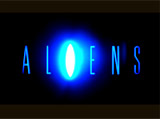
|
His sequel to Ridley Scott's original film Alien (1979) was notable for the way it combined numerous in-camera special-effects elements and techniques into the same shot. Live action, models (full-sized and scale miniatures of the alien Queen), matte paintings, composites, front and rear projection, and various other elements were brought together through a beam-splitter. |

|
||||||

|
Flight of the Navigator (1986) Director Randal Kleiser's and Disney's sci-fi-comedy (called "the ultimate fantasy") followed on the heels of many other kids' adventure films with aliens and space themes (i.e., E.T.: The Extra-Terrestrial (1982)). This fantasy was set in the year 1986. It began with the discovery of the kidnapping-abduction of 12 year-old David Freeman (Joey Cramer) by aliens eight years earlier, but he had not aged. Ominous NASA scientists wanted to scan and test David's brain at a top-secret research lab - and discovered his mind was filled with star charts, and alien and technical information. To try to understand what had happened to him and also to find his way home (to the original year of 1978), David escaped from the lab and befriended an alien life form - a flying spaceship controlled by an AI computer robot pilot named MAX (aka Trimaxion Drone Ship) (voice of Paul Reubens). The research spaceship (rendered in CGI) also had an assortment of extraterrestrial creatures on board (for example, a bat-like alien named Puckmaren). The boy came to understand that he was the "Navigator" of the film's title. It was revealed that David had been flown to the distant planet of Phaelon to be analyzed as a human specimen, and then returned to earth, although years later.
It was the first feature film to use 'reflection mapping' to provide digital gloss -- for the shiny, silvery surface or reflective metallic skin of the flying CGI alien spaceship as it zoomed over the landscape (of the Everglades in Florida) and reflected airports, fields, buildings, and oceans. [Note: This technique was also used in Terminator 2: Judgment Day (1991), and also for the reflective Naboo spacecraft in Star Wars Episode I: The Phantom Menace (1999).] |
 David Freeman (Joey Cramer)  Odd-shaped Brain Scans  MAX  Puckmaren |
||||||

|
The Great Mouse Detective (1986) During the complex chase scene at the end of the film within London's famed bell tower Big Ben, Basil pursued the evil Ratigan through a complex environment of interlocking gears and cogs. The images of the turning, interlocking cogs/gears of the clock (in the background) were modeled and animated with 3-D computer animation techniques, while the characters were drawn by hand. The wireframes were output to animation cells (or drawings) on paper with a pen plotter, and then hand-painted. They were then integrated with the foreground hand-drawn characters during the production process. |
 Wire-Framing 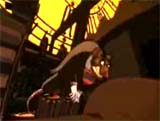  The Big Ben Tower Chase |
||||||

|
Howard the Duck (1986) This George Lucas film was the first film to use digital wire removal or deletion, a technique pioneered by Industrial Light and Magic (ILM). Wires were used in live-action filming to simulate either flying actors or miniatures. Howard the Duck was portrayed by stunt men in a duck suit. [Note: The technique was also used in Back to the Future Part II (1989), and Hook (1991).] |

|
||||||

|
Labyrinth (1986) The memorable CGI opening credits/title sequence included a digitally-created flying owl (the first photo-realistic CGI animal in a feature film) and a crystal glass ball. The owl was given tone mattes on each individual feather, to heighten the illusion of realism. The film also featured M.C. Escher-style production design, including the final "stairway sequence" - in the upside-down room in the Goblin City (modeled after Escher's "Relativity" drawing of stairs on different planes). In the ever changing maze environment of the Labyrinth, Jareth the Goblin King's (David Bowie) crystal ball bounced across the multiple perspectives of the room and up a flight of stairs - directly into the hand of Sarah's (Jennifer Connelly) baby stepbrother Toby (Toby Froud) -- it was a reversed shot. |
   
|
||||||

|
Luxo Jr. (1986) It was also the first computer (CG) animation short to be nominated for an Academy Award. The desk lamp later became the corporate or trademark symbol for Pixar. It was notable as the first fully computer-generated, computer-animated (or CGI) film, and the first to use shadows in CGI (made possible by Renderman software). |
 
|
||||||

|
Star Trek IV: The Voyage Home (1986) This was the first groundbreaking, cinematic use of 3D scanning by Cyberware scanning software. [Note: Cyberware pioneered the market for three-dimensional detailed scans of people and objects. The laser- and video-based technology could scan complex objects in only seconds to produce a detailed three-dimensional data-set of the facial features and a detailed texture map of the surface color.] This type of 3D scanning was first used on the heads of Star Trek actors when ILM digitized them for a short time-warp travel scene. The CG heads of William Shatner and Leonard Nimoy were too complex for conventional modeling techniques at the time - instead they were scanned by the first Cyberware 3D Scanner, to produce disembodied cyber-sculptures of their heads. In the film, the Enterprise officers were forced to sling-shot themselves around the Sun in order to time-travel back to the late 20th century from the 23rd century - their objective was to locate humpback whales and bring them forward in time to save the doomed planet Earth from a destructive, power-sucking probe. |
   
|
||||||
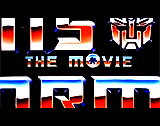
|
The Transformers: The Movie (1986) Based on the popular weekday afternoon cartoon series during the 80s, this full-length animated adventure about giant, alien robot warriors was another early melding of traditional and computer animation, using TRON-style backlighting. The main plot was about warriors known as The Transformers, from a planet called Cybertron. There was conflict between the two factions:
The Decepticons were allied with the colossal, planet-devouring Unicron (voiced by Orson Welles in his final role). In its downbeat, apocalyptic plot (with a cliffhanger ending) all of the series marquee regulars were killed off in the Battle of Autobot City. |
 
|
||||||

|
Captain Power and the Soldiers of the Future (1987-1988, Canada/US) - TV This was the first science fiction-action TV series (of 22 episodes airing from 1987-1988) that merged live action with CGI animation. It was the first TV series to include modeled 3D characters entirely computer-created. Soaron (voice of Deryck Hazel) and later Blastarr (voice of John S. Davies) were two primitive CGI robots that appeared in the series. Soaron was armed with a digitizer ray that could turn humans into computer data, which was then fed into a supercomputer called Overmind (voice of Ted Dillon). Although funded by Mattel and advertised as a children's series, it was incredibly violent. It was expensive (a million dollars per episode), with its innovative special effects. It told about two warring factions in the 22nd Century (in the year 2147 on Earth):
|
  Soaron - a Bio-Dread (or Advanced Bio-Mech) |
||||||
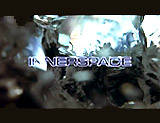
|
Innerspace (1987)
It was visually cartoonish and dazzling, with its zany tale of a secret medical-surgical experiment performed on hot-shot Navy test pilot Lt. Tuck Pendleton (Dennis Quaid), who was estranged from his girlfriend Lydia Maxwell (Meg Ryan). While in a submersible pod-craft, Tuck was shrunk to molecular size and was to be inserted into the body of a live rabbit via a syringe. Things became manic and complicated when competing thieves, led by scientist Dr. Margaret Canker (Fiona Lewis) and Victor Scrimshaw (Kevin McCarthy), sabotaged the experiment. They attempted to steal the miniaturized Pendleton and his tiny vessel - which were injected from the syringe holding them into a second individual - hypochondriacal grocery store clerk Jack Putter (Martin Short). There was a unique F/X sequence of the use of forced-perspective in a car racing on the streets of San Francisco. The normal sized heroes, Lydia and Jack were in the front seat, fighting with the half-sized miniaturized villains Dr. Canker and Victor in the back-seat - in real-time. And shots of the interior blood-stream - and of the fetus of Tuck's son (or daughter) - when Tuck was transferred from Jack to Lydia - were also amazing. |
 Lt. Tuck Pendleton At Controls 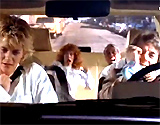 Forced Perspective 
The Fetus |
||||||
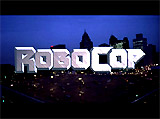
|
Robocop (1987) Director Paul Verhoeven's action film (his first major Hollywood production) had the tagline: "PART MAN, PART MACHINE, ALL COP" - referring to the title character, a superhuman cyborg law enforcer known as "RoboCop." Two different traditional techniques were used in the scenes involving an ED-209 (Enforcement Droid) prototype at the Omni Consumer Products (OCP) headquarters:
In a scene late in the film, the incompetent, robotic, 24-hour-a-day law enforcer was introduced as "the future of law enforcement."
It embarrassingly malfunctioned during the product display and massacred one of the executive board members. The demonstrator yelled out: "Somebody want to call a god-damn paramedic!" It was excused with: "I'm sure it's only a glitch, a temporary setback." [Note: This old-fashioned technique was soon to be overtaken by computer-generated imagery (CGI).] |
    
|
||||||
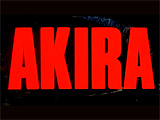
|
Akira (1988, Jp.) An excellent example of a feature-length, science-fiction Japanese anime - "Japanimation" - from director Katsuhiro Otomo, and based on his science-fiction comic book (manga) of the same name. Akira has often been considered the greatest animated film of all time, with advanced technical features, such as highly-detailed scenes (with textures, shadows, unusual colors), and seamless animation with over 160,000 animation cels. At its time, it was the most expensive film ever produced in Japan ($8 million). |

|
||||||

|
Tin Toy (1988) Pixar's and director John Lasseter's 5-minute short film was the first fully computer animated (CGI) film to win an Academy Award Oscar - for Animated Short Film. It was a reaffirming test of the power of PhotoRealistic RenderMan software. Billy, the drooling baby character in the short film, marked the first time that a CG character had realistic human qualities. Tinny, the one-man-band tin toy hero of Tin Toy, was to be the central character in Toy Story (1995) - until Buzz Lightyear was created. |
 
|
||||||

|
Who Framed Roger Rabbit (1988)
It was a coordinated effort (produced by Disney, live-action directed by Robert Zemeckis, and animated by Richard Williams) - a remarkable blend of animated imagery (hand drawn and painted), and hand matched to the live action human characters, and filmed as a tribute to the entire pantheon of cartoon characters from Disney, Warner Bros., and MGM, and other studios in the 1940s. The remarkable animation included sophisticated shading, lighting and shadows to dramatically make the hand-drawn animated characters appear very 3-D and lifelike as they interacted with real-world objects and people. |
  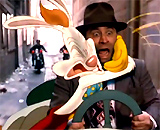
|
||||||

|
Willow (1988) The film's most detailed and fluid morph was in the scene of a halfling farmer and inept magician named Willow (Warwick Davis) finally turning Fin Raziel (Patricia Hayes) back into her original human form as an old sorceress woman. She went through various animal changes in the film, from a rodent to a crow, then to a goat, ostrich, and lastly into a roaring tiger before becoming a human shape. This morphing was revolutionary because the shape-shifting occurred between real objects, not just between CG creations. [Note: The same 'morphing' effect was used much more extensively in Terminator 2: Judgment Day (1991) and in the conclusion of Indiana Jones and the Last Crusade (1989) - see below. Digital morphing was also later used in Star Trek VI: The Undiscovered Country (1991).] |
   
|
||||||